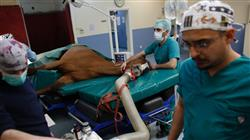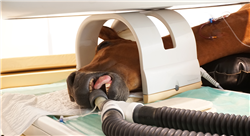University certificate
The world's largest faculty of veterinary medicine”
Introduction to the Program
Equine veterinarians are currently in demand by the owners of these animals. So don't think twice and increase your skills to improve their treatment"
In the last 20 years, veterinary anesthesia in major species has experienced great progress thanks to the introduction of new techniques and drugs, as well as the development of specific anesthetic monitors and machines.
Additionally, the introduction of new surgical techniques has created the need to develop new anesthetic protocols, and there is a growing concern about the impact of anesthesia and analgesia on animal welfare and on the final outcome of surgical procedures.
The equine veterinary clinic also requires constant updating on the part of the veterinarian, as it encompasses numerous and complex specialties in continuous development. It is a highly competitive professional sector that quickly incorporates new scientific advances into the outpatient clinic, so the veterinarian deals with a labor market that demands a very high level of competence in all aspects.
The mobile veterinarians' daily work is very demanding in terms of the number of working hours, both because of the volume of hours involved in the mobile visits and because of the degree of personal dedication and the time required for the administrative management of their own company. For this reason, they often lack the free time they need to continue their training in person at accredited centers, and in many instances resort to consulting procedures and other information on the Internet. In the network, the professional expects to find reliable online training.
Taking into account the need for competent and quality online training, we present this Advanced master’s degree in Equine Anesthesia and Surgery, which has revolutionized the world of veterinary specialization, both for its contents, as well as for its teaching staff and its innovative teaching methodology.
Furthermore, as it is a 100% online specialization, the student decides where and when to study. Without the restrictions of fixed timetables or having to attend classes, which facilitates the conciliation of family and professional life.
A high level scientific program, supported by advanced technological development and the teaching experience of the best professionals”
This Advanced master’s degree in Equine Anesthesia and Surgery contains the most complete and up to date academic program on the market. The most important features include:
- The latest technology in online teaching software
- A highly visual teaching system, supported by graphic and schematic contents that are easy to assimilate and understand
- Practical cases presented by practising experts
- State-of-the-art interactive video systems
- Teaching supported by telepractice
- Continuous updating and recycling systems
- Autonomous learning: full compatibility with other occupations
- Practical exercises for self assessment and learning verification
- Support groups and educational synergies: questions to the expert, debate and knowledge forums
- Communication with the teacher and individual reflection work
- Content that is accessible from any fixed or portable device with an internet connection
- Supplementary documentation databases are permanently available, even after the course
A program created for professionals who aspire to excellence that will allow you to acquire new skills and strategies in a smooth and effective way"
Our teaching staff is made up of working professionals. In this way, we ensure that we provide the up to date training we are aiming for. A multidisciplinary team of professionals trained and experienced in different environments, who will develop the theoretical knowledge efficiently, but, above all, will put at the service of the training the practical knowledge derived from their own experience.
This mastery of the subject is complemented by the effectiveness of the methodological design of this Advanced master’s degree. Developed by a multidisciplinary team of e-learning experts, it integrates the latest advances in educational technology. In this way, you will be able to study with a range of comfortable and versatile multimedia tools that will give you the operability you need in this training.
The design of this program is based on Problem-Based Learning, an approach that sees learning as a highly practical process. To achieve this remotely, we will use telepractice. With the help of an innovative interactive video system and Learning from an Expert, you will be able to acquire the knowledge as if you were facing the scenario you are currently learning. A concept that will make it possible to integrate and fix learning in a realistic and permanent way.
We give you the opportunity to take a deep and complete dive into the strategies and approaches in Equine Anesthesia and Surgery"

Our innovative telepractice concept will give you the opportunity to learn through an immersive experience, which will provide you with a faster integration and a much more realistic view of the contents: Learning from an Expert”
Why study at TECH?
TECH is the world’s largest online university. With an impressive catalog of more than 14,000 university programs available in 11 languages, it is positioned as a leader in employability, with a 99% job placement rate. In addition, it relies on an enormous faculty of more than 6,000 professors of the highest international renown.

Study at the world's largest online university and guarantee your professional success. The future starts at TECH”
The world’s best online university according to FORBES
The prestigious Forbes magazine, specialized in business and finance, has highlighted TECH as “the world's best online university” This is what they have recently stated in an article in their digital edition in which they echo the success story of this institution, “thanks to the academic offer it provides, the selection of its teaching staff, and an innovative learning method aimed at educating the professionals of the future”
A revolutionary study method, a cutting-edge faculty and a practical focus: the key to TECH's success.
The most complete study plans on the university scene
TECH offers the most complete study plans on the university scene, with syllabuses that cover fundamental concepts and, at the same time, the main scientific advances in their specific scientific areas. In addition, these programs are continuously being updated to guarantee students the academic vanguard and the most in-demand professional skills. In this way, the university's qualifications provide its graduates with a significant advantage to propel their careers to success.
TECH offers the most comprehensive and intensive study plans on the current university scene.
A world-class teaching staff
TECH's teaching staff is made up of more than 6,000 professors with the highest international recognition. Professors, researchers and top executives of multinational companies, including Isaiah Covington, performance coach of the Boston Celtics; Magda Romanska, principal investigator at Harvard MetaLAB; Ignacio Wistumba, chairman of the department of translational molecular pathology at MD Anderson Cancer Center; and D.W. Pine, creative director of TIME magazine, among others.
Internationally renowned experts, specialized in different branches of Health, Technology, Communication and Business, form part of the TECH faculty.
A unique learning method
TECH is the first university to use Relearning in all its programs. It is the best online learning methodology, accredited with international teaching quality certifications, provided by prestigious educational agencies. In addition, this disruptive educational model is complemented with the “Case Method”, thereby setting up a unique online teaching strategy. Innovative teaching resources are also implemented, including detailed videos, infographics and interactive summaries.
TECH combines Relearning and the Case Method in all its university programs to guarantee excellent theoretical and practical learning, studying whenever and wherever you want.
The world's largest online university
TECH is the world’s largest online university. We are the largest educational institution, with the best and widest online educational catalog, one hundred percent online and covering the vast majority of areas of knowledge. We offer a large selection of our own degrees and accredited online undergraduate and postgraduate degrees. In total, more than 14,000 university degrees, in eleven different languages, make us the largest educational largest in the world.
TECH has the world's most extensive catalog of academic and official programs, available in more than 11 languages.
Google Premier Partner
The American technology giant has awarded TECH the Google Google Premier Partner badge. This award, which is only available to 3% of the world's companies, highlights the efficient, flexible and tailored experience that this university provides to students. The recognition as a Google Premier Partner not only accredits the maximum rigor, performance and investment in TECH's digital infrastructures, but also places this university as one of the world's leading technology companies.
Google has positioned TECH in the top 3% of the world's most important technology companies by awarding it its Google Premier Partner badge.
The official online university of the NBA
TECH is the official online university of the NBA. Thanks to our agreement with the biggest league in basketball, we offer our students exclusive university programs, as well as a wide variety of educational resources focused on the business of the league and other areas of the sports industry. Each program is made up of a uniquely designed syllabus and features exceptional guest hosts: professionals with a distinguished sports background who will offer their expertise on the most relevant topics.
TECH has been selected by the NBA, the world's top basketball league, as its official online university.
The top-rated university by its students
Students have positioned TECH as the world's top-rated university on the main review websites, with a highest rating of 4.9 out of 5, obtained from more than 1,000 reviews. These results consolidate TECH as the benchmark university institution at an international level, reflecting the excellence and positive impact of its educational model.” reflecting the excellence and positive impact of its educational model.”
TECH is the world’s top-rated university by its students.
Leaders in employability
TECH has managed to become the leading university in employability. 99% of its students obtain jobs in the academic field they have studied, within one year of completing any of the university's programs. A similar number achieve immediate career enhancement. All this thanks to a study methodology that bases its effectiveness on the acquisition of practical skills, which are absolutely necessary for professional development.
99% of TECH graduates find a job within a year of completing their studies.
Advanced Master's Degree in Equine Anesthesia and Surgery
.
Faced with a sector that increasingly demands specialized veterinary care in equine clinical practice, the preparation of professionals in the latest procedures for diagnosis, treatment and prevention of diseases in horses is essential. At TECH Global University we have developed the Advanced Master's Degree in Equine Anesthesia and Surgery, a program that integrates the latest advances in this field. Thus, you will be able to cover the most important concepts and topics to strengthen your conceptual background, skills and technical competencies, in addition to applying the most advanced methods in your interventions in order to offer a quality service that will make you stand out.
Specialize in Equine Anesthesia and Surgery
.
If you want to enhance your professional profile, hone your skills to stand out in a developing field, and acquire a qualification that will allow you to further advance your career goals, our Advanced Master's Degree is for you. With a curriculum designed with the highest academic rigor, you will delve into the areas of anesthesiology, clinical medicine and surgery in order to treat the various types of pathologies that affect horses. You will study the most common alterations present in blood, ultrasound and radiographic analysis, as well as the associated and predisposed diseases of this species that require surgical intervention. In this way, providing the most appropriate prognosis and treatment, you will master the approach to various conditions that affect the welfare of equines. Get certified at the largest Veterinary School and take a leap towards a better working future.








